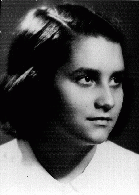You searched for: 回国加速器【输入∶海归returnees加速器】海归returnees加速器app海归returnees加速器publishers海归returnees加速器top海归returnees加速器published海归returnees加速器apps海归returnees加速器and海归returnees加速器more海归returnees加速器in海归returnees加速器United海归returnees加速器States海归returnees加速器Google海归returnees加速器Play海归returnees加速器Store
<< Previous | Displaying results 2251-2300 of 2676 for "回国加速器【输入∶海归returnees加速器】海归returnees加速器app海归returnees加速器publishers海归returnees加速器top海归returnees加速器published海归returnees加速器apps海归returnees加速器and海归returnees加速器more海归returnees加速器in海归returnees加速器United海归returnees加速器States海归returnees加速器Google海归returnees加速器Play海归returnees加速器Store" | Next >>
-
Madeline Deutsch describes her postwar experiences
Oral HistoryMadeline was born into a middle class family in an area of Czechoslovakia that was annexed by Hungary in 1938-1939. Her father worked out of their home and her mother was a homemaker. Madeline attended high school. In April 1944 her family was forced into a Hungarian ghetto. The family lived in the ghetto for two weeks before being transported to Auschwitz. Madeline and her mother were separated from her father and older brother. Neither her father nor brother survived the war. A week after arriving in…
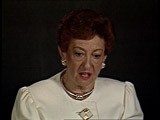
-
George Salton describes liberation by American forces
Oral HistoryGeorge was liberated by the American forces in May 1945. He had spent three years during the war in ten different concentration camps. In 1945 he was in the Woebbelin camp in Germany. After liberation, he spent over two years in various displaced persons camps. George immigrated to the United States in October 1947.
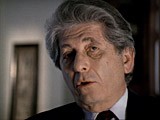
-
Martin Strauss describes German soldiers searching his family at the German border with Italy
Oral HistoryIn 1938, Martin's father was imprisoned during Kristallnacht (the "Night of Broken Glass"). Upon the intervention of the family's chauffeur, a gentile, Martin's father was released after three days. The family obtained visas to immigrate to Palestine and left Germany in 1939. Martin aided "illegal" immigrants who defied British restrictions on immigration into Palestine. He was imprisoned by the British in 1947 and forbidden to live in Palestine. He then came to the United States.

-
Hessy Levinsons Taft describes father's attempts to obtain visas for the family to emigrate from Nice, in the south of France
Oral HistoryAs prewar antisemitism intensified, Hessy's family fled from Germany to Paris, France. France fell to the German army in June 1940. Hessy's family was smuggled into the "zone libre" (free zone) in southern France. The family received a US visa in 1941, but was unable to leave before the visa expired and could not obtain an extension. In 1942, the family obtained visas to enter Cuba, where they settled before immigrating to the United States in 1949.

-
Morris Kornberg describes arrival at Auschwitz
Oral HistoryMorris grew up in a very religious Jewish household and was active in a Zionist sports league. When the Germans invaded Poland in September 1939, Morris's town was severely damaged. Morris's family was forced to live in a ghetto, and Morris was assigned to forced labor. After a period of imprisonment in Konskie, a town about 30 miles from Przedborz, Morris was deported to the Auschwitz camp. He was assigned to the Jawischowitz subcamp of Auschwitz. In January 1945, Morris was forced on a death march and…
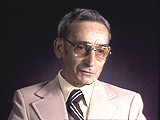
-
Sally Pitluk describes her removal from forced labor at Budy
Oral HistorySally Pitluk was born to Jewish parents in Płońsk, Poland in 1922. A few days after the German invasion of Poland in 1939, Płońsk was occupied. Sally and her family lived in a ghetto from 1940-1942. In October of 1942, Sally was transported to Auschwitz, where she was tattooed and moved into the subcamp Budy for forced labor. She stayed in the Auschwitz camp complex until the beginning of 1945 when she and other prisoners were death marched to several different camps. She was liberated in 1945 and…

-
Belle Mayer Zeck reflects upon people who have dedicated their lives to the cause of human rights
Oral HistoryBelle Mayer trained as a lawyer and worked for the General Counsel of the US Treasury, Foreign Funds Control Bureau. This bureau worked to enforce the Trading With the Enemy Act passed by Congress. In this capacity, Mayer became familiar with the German I. G. Farben chemical company, a large conglomerate that used slave labor during World War II. In 1945, Mayer was sent as a Department of Treasury representative to the postwar London Conference. She was present as representatives from the Allied nations…
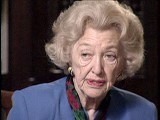
-
Children during the Holocaust
ArticleChildren were especially vulnerable to Nazi persecution. Learn more about the fates of Jewish and non-Jewish children.

-
Antisemitism
Media EssayThe word antisemitism means prejudice against or hatred of Jews. The Holoca...
-
Identification papers issued to Erika Tamar
DocumentIdentification papers issued to Erika Tamar stating that she was born in Vienna on June 10, 1934. Erika was one of the 50 children rescued by Gilbert and Eleanor Kraus.

-
The German parliament building burns in Berlin
PhotoThe Reichstag (German parliament) building burns in Berlin. Hitler used the event to convince President Hindenburg to declare a state of emergency, suspending important constitutional safeguards. Germany, February 27, 1933.
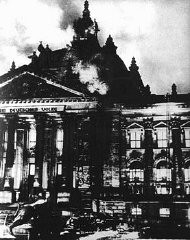
-
Assault on individual freedoms
PhotoAfter Adolf Hitler became chancellor of Germany, he persuaded his cabinet to declare a state of emergency and end many individual freedoms. Here, police search a vehicle for arms. Berlin, Germany, February 27, 1933.
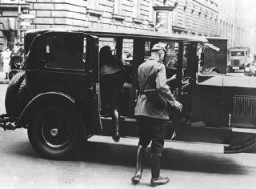
-
Members of the Hlinka Guard and a squad of ethnic Germans
PhotoMembers of the Hlinka Guard and a squad of ethnic Germans march during a parade in Slovakia, a Nazi satellite state. Date uncertain.
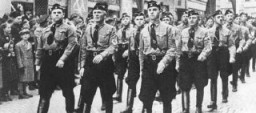
-
Ustaša soldiers oversee the deportation of civilians
PhotoUstaša (Croatian fascist) soldiers oversee the deportation of a group of civilians from Kozara region to a concentration camp, in the pro-German fascist state of Croatia established following the partition of Yugoslavia. Croatia, between 1941 and 1944.

-
Damaged dome of the Reichstag
PhotoDome of the Reichstag (German parliament) building, damaged by fire on February 27, 1933. Hitler used the arson to convince President Hindenburg to declare a state of emergency, suspending constitutional safeguards. Berlin, Germany, 1933.

-
Joseph Goebbels during the Reichstag Fire Trial
PhotoJoseph Goebbels (standing) testifies for the state during the Reichstag Fire Trial before the Supreme Court. Leipzig Germany, 1933.
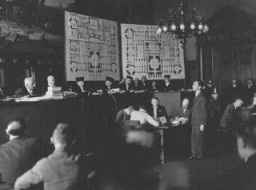
-
Members of the paramilitary organization of the Dutch Nazi Party
PhotoMembers of the paramilitary organization of the Dutch Nazi Party stand in the doorway of a restaurant. The sign states "Jews are not desired." Amsterdam, the Netherlands, 1941–42.
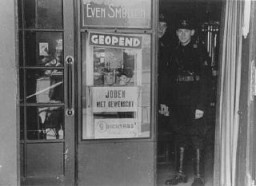
-
Gestapo headquarters in Rome, Italy
PhotoA building in Rome, Italy, used as Gestapo (secret state police) headquarters during the German occupation. This photograph was taken after US forces liberated the city. Rome, Italy, June 1944.
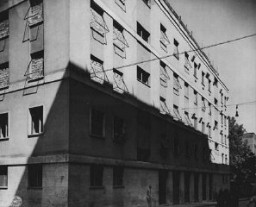
-
Trial of Klaus Barbie
PhotoThe courtroom where Klaus Barbie, former Gestapo (German Secret State Police) chief in Lyon, was tried on charges of crimes against humanity. Lyon, France, May 1987.

-
Eichmann sentenced to death
PhotoDefendant Adolf Eichmann stands as he is sentenced to death by the court. The execution of Eichmann remains the only time the State of Israel has enacted a death sentence. Jerusalem, Israel, December 15, 1961.
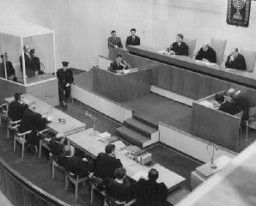
-
Ernst Kaltenbrunner
ArticleBrief overview of the charges against Ernst Kaltenbrunner, Reich Security Main Office leader, during the International Military Tribunal at Nuremberg.
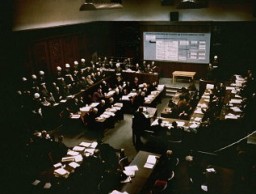
-
Who Was Put on Trial?
ArticleThe International Military Tribunal charged 24 defendants representing a cross-section of German diplomatic, economic, political, and military leadership.
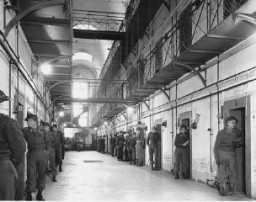
-
Images of Sobibor from deputy camp commandant Johann Niemann's album
Media EssayView rare photographs of the Sobibor killing center, including never-before-seen images of the site, barracks buildings, workshops, and SS and Ukrainian guards.
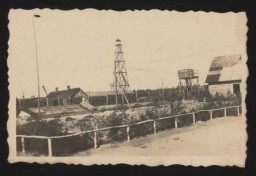
-
Some Were Neighbors
FilmHow was the Holocaust possible? The central role of Hitler and other Nazi Party leaders is indisputable. Less well understood is these perpetrators’ dependence on countless others. In countries across Europe, tens of thousands of ordinary people actively collaborated with German perpetrators of the Holocaust. Many more supported or tolerated the crimes. The special exhibition Some Were Neighbors: Collaboration & Complicity in the Holocaust was underwritten in part by grants from The David Berg…
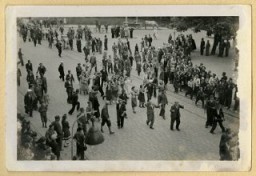
-
Ghettos in occupied Poland, 1939-1941
MapGermany occupied western Poland in fall 1939. Much of this territory was annexed to the German Reich. Eastern Poland was not occupied by German forces until June 1941. In south-central Poland the Germans set up the Generalgouvernement (General Government), where most of the early ghettos were established. Ghettos were enclosed districts of a city in which the Germans forced the Jewish population to live under miserable conditions. Ghettos isolated Jews by separating Jewish communities both from the…

-
Major Nazi camps in Europe, January 1944
MapThroughout German-occupied Europe, the Germans arrested those who resisted their domination and those they judged to be racially inferior or politically unacceptable. People arrested for resisting German rule were mostly sent to forced-labor or concentration camps. The Germans deported Jews from all over occupied Europe to extermination camps in Poland, where they were systematically killed, and also to concentration camps, where they were used for forced labor. Transit camps such as Westerbork, Gurs,…

-
Rescue in Budapest, 1944-1945
MapRaoul Wallenberg, a Swedish businessman assigned as a diplomat to Sweden's embassy in Budapest, led one of the most extensive and successful rescue efforts during the Holocaust. Supported by the American War Refugee Board (WRB) and the American Jewish Joint Distribution Committee, Wallenberg protected tens of thousands of Hungarian Jews, issuing documents testifying that the Jews were under the protection of neutral Sweden. Diplomats from other neutral countries also participated in the rescue effort. Carl…

-
Karl Höcker relaxes with SS physicians
PhotoKarl Höcker (on left, looking at the camera) relaxes with SS physicians, including Dr. Fritz Klein (far left), Dr. Horst Schumann (partially obscured next to Klein, identified from other photographs), and Dr. Eduard Wirths (third from right, wearing tie). From Karl Höcker's photograph album, which includes both documentation of official visits and ceremonies at Auschwitz as well as more personal photographs depicting the many social activities that he and other members of the Auschwitz camp…
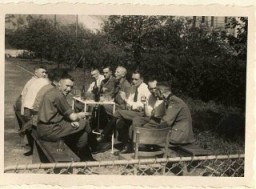
-
Richard Baer, Karl Höcker, and Dr. Enno Lolling
PhotoRichard Baer and Karl Höcker look over a document with SS-Standartenführer Dr. Enno Lolling, the director of the Office for Sanitation and Hygiene in the Inspectorate of Concentration Camps. From left to right: Lolling, Baer, Höcker. From Karl Höcker's photograph album, which includes both documentation of official visits and ceremonies at Auschwitz as well as more personal photographs depicting the many social activities that he and other members of the Auschwitz camp staff enjoyed.…
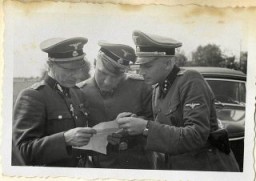
-
Nazi ceremony in Auschwitz-Birkenau
PhotoThe beginning of a ceremony to dedicate a new SS hospital in Auschwitz-Birkenau. A Nazi soldier salutes as the Nazi and SS flags are raised while a line of troops stand with rifles at attention during the dedication. From Karl Höcker's photograph album, which includes both documentation of official visits and ceremonies at Auschwitz as well as more personal photographs depicting the many social activities that he and other members of the Auschwitz camp staff enjoyed. These rare images show Nazis…

-
Richard Baer at a ceremony
PhotoSeptember 1, 1944, Richard Baer ceremonially accepts a copy of the construction plans from the Chief of the Central Construction Directorate of the Waffen SS, SS-Sturmbannführer Karl Bischoff, celebrating the opening of an SS military hospital (SS-Lazarette). Baer was the last commandant of the Auschwitz camp. From Karl Höcker's photograph album, which includes both documentation of official visits and ceremonies at Auschwitz as well as more personal photographs depicting the many social…
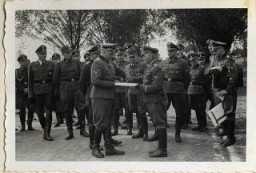
-
Day trip for SS female auxiliaries
PhotoSS female auxiliaries getting off the bus on a day trip in July 1944; this image contrasts starkly with the arrival of a deported Hungarian men, women, and children in Auschwitz-Birkenau in May 1944. From Karl Höcker's photograph album, which includes both documentation of official visits and ceremonies at Auschwitz as well as more personal photographs depicting the many social activities that he and other members of the Auschwitz camp staff enjoyed. These rare images show Nazis singing, hunting, and…

-
Antisemitism in History: The Era of Nationalism, 1800–1918
ArticleLearn how the rise of nationalism in Europe (1800–1918) resulted in new forms of prejudice against Jews based on political, social, and economic considerations.

-
Jakub Lapides
ArticleYoung people's diaries bear witness to some of the most heartbreaking experiences of the Holocaust. Learn about the diary and experiences of Jakub Lapides.
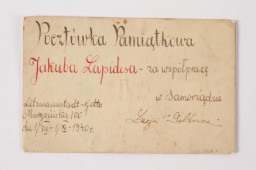
-
Gassing Operations
ArticleThe Nazis used poisonous gas to murder millions of people in gas vans or stationary gas chambers. The vast majority of those killed by gassing were Jews.
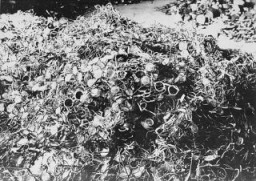
-
Jewish Losses during the Holocaust: By Country
ArticleBefore the Nazi rise to power, the countries of Europe had varied and vibrant Jewish communities. By 1945, two out of every three European Jews had been killed.

-
Landsberg Displaced Persons Camp
ArticleAfter WWII, many Holocaust survivors, unable to return to their homes, lived in displaced persons camps in Germany, Austria, and Italy. Read about Landsberg DP camp.
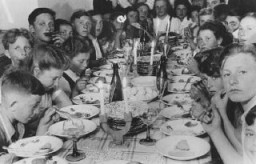
-
Righteous Among the Nations
ArticleRighteous Among the Nations are non-Jewish individuals honored by Yad Vashem, Israel's Holocaust memorial, for risking their lives to aid Jews during the Holocaust.

-
Youth at vocational training in Kloster Indersdorf
PhotoThe Kloster Indersdorft displaced persons camp opened in July 1945. By mid-September, 1945, 192 boys and girls from thirteen nations, including 49 Jewish children, were sheltered at Kloster Indersdorf, more than double what had been anticipated. Over the next year, the numbers increased to over 300. Five hours each day were allocated to education. Teachers were drawn from the staff as well as the local community. Many of the children had few or no literacy skills; they also benefitted from art, music,…
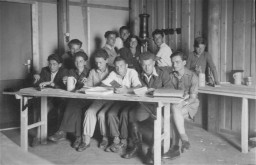
-
Establishment of Dachau Camp
Timeline EventMarch 22, 1933. On this date, the SS established the Dachau concentration camp in Germany.
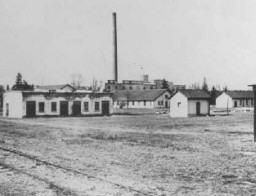
-
Antisemitic Exhibition Opens in Munich
Timeline EventNovember 8, 1937. On this date, Josef Goebbels and Julius Streitcher open an antisemitic exhibit named "Der Ewige Jude."
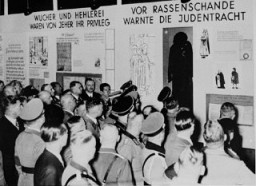
-
People crowded around an antisemitic "Pesti Ujság" newspaper display
PhotoVisitors view the exhibition of the Arrow Cross newspaper, Pesti Ujság, at the International Fair in Budapest. The headline reads: "For a Hungary without Jews." Budapest, Hungary, approximately 1941-1942. The Arrow Cross was Hungary's largest fascist political movement after 1935. In the 1939 parliamentary elections it won over 20% of the vote and had more than 250,000 members. Its ideology was ultra-nationalistic and fiercely antisemitic. The Arrow Cross viewed Jews as an "anti-national" "race"…
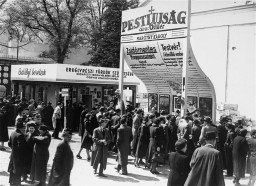
-
SS officers socialize at an SS retreat outside of Auschwitz
PhotoThis photograph shows a group of SS officers at Solahütte, the SS retreat outside of Auschwitz. Pictured from left to right: Richard Baer, Dr. Josef Mengele, and Rudolf Höss. From Karl Höcker's photograph album, which includes both documentation of official visits and ceremonies at Auschwitz as well as more personal photographs depicting the many social activities that he and other members of the Auschwitz camp staff enjoyed. These rare images show Nazis singing, hunting, and even trimming a Christmas…

-
Gay Men and Lesbians under the Nazi Regime
SeriesThe Nazi regime harrassed and targeted gay men and lesbians. For gay men, this harassment turned into brutal persecution. Browse these articles to learn more.
-
An older Jewish man sits on the Adonis fountain on the main square in Lwów, Poland, circa 1938
PhotoThis photograph shows a market scene at the main square in Lwów, Poland, shortly before the outbreak of World War II. Sitting on the fountain is a man holding a chicken and a basket, likely filled with groceries. His long beard and style of dress, including the overcoat and fedora, identify him as a more traditional, religious Jew. Traditionally, observant Jewish men wore beards and kept their heads covered. An elderly woman selling produce sits on the pavement near the man. In contrast to the man, the…

-
Urszula Kaczmarek
ID CardUrszula was one of four children born to Franciszek and Jadwiga Kaczmarek, who lived in the industrial city of Poznan in western Poland. The family lived at 11 Smolnej Street. Like their parents, the Kaczmarek children were baptized in the Roman Catholic faith. 1933-39: As one of the older children in the family, Urszula helped her mother with the housework. She was 10 years old when the Germans invaded Poland on Friday, September 1, 1939. German planes bombed Poznan that same day, and German troops…
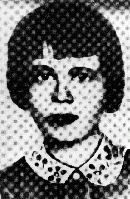
-
Maurits Wijnberg
ID CardMaurits was one of four children born to religious Jewish parents living in the town of Leek. When he was 12, the Wijnbergs moved to the town of Zwolle, where they ran a kosher hotel. That same year, Maurits became ill with meningitis. After he recovered, he worked hard to compensate for missed school and became an exceptional student. 1933-39: Along with his younger sister, Maurits was active in the local Zionist organization. One of the group's activities was raising money for Palestine [Yishuv]. Every…

-
Marthijn Wijnberg
ID CardWhen Marthijn was 10, his religious Jewish family moved from Groningen to the town of Zwolle. There, his parents ran the only kosher hotel in the region. The Wijnbergs had two other sons and a daughter. All of the children attended Dutch public schools, and four afternoons a week they also went to religious school to study Jewish history, Hebrew and the Bible. 1933-39: Marthijn could play almost any instrument, including piano, saxophone and accordion. Sometimes each of his brothers would pick up an…
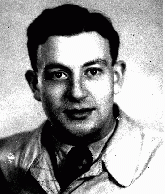
-
Mario Finzi
ID CardMario was the only child of a Jewish couple who were secondary school teachers in Bologna. Like many Italian Jews, his family was well-integrated into Italian society. Even though Fascist leader Benito Mussolini came to power in 1922, Jews in Italy continued to live in safety. Mario played piano as a hobby. When he finished high school in Bologna, Mario went on to study law. 1933-39: In 1938 Mario began practicing law in Milan. But later that year, Mussolini's government issued "racial" laws that…

-
Zofia Rapaport
ID CardZofia was born to a Jewish family in Warsaw. Zofia's father, a self-made man who had put himself through university, was a successful banker. The Rapaports lived on a street of single-family homes with gardens. Zofia's room was decorated with yellow lacquered furniture. 1933-39: As a young child, Zofia loved to play with her dog, Chapek. Sometimes she got to go shopping with her mother downtown. Each year during the Jewish holiday of Passover her family visited Zofia's grandparents in Lvov. In late August…
